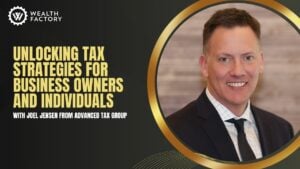Just about everyone would like to know the best debt reduction planning strategies for them, but almost no one knows the best way to efficiently go about reducing debt. In today’s episode, we talk about the 3 R’s of Debt Reduction Planning, along with the best strategies for reducing debt in the most efficient way. Let’s jump right in!
The first thing to realize is that not all debt is bad, and the first step to debt reduction planning is to determine which ones are efficient debts, and which ones are inefficient debts. The way that we do that at Wealth Factory is through the Cash Flow Index. It’s a special formula that we’ve created to help identify efficient debts and remove them from the conversation so that we can focus on eliminating inefficient debts first. The reason this is so important is that people are constantly chasing returns, and the best return is often received by eliminating that inefficient debt first.

So what is inefficient debt?
Inefficient debt typically results from personal loans, credit card loans, and sometimes auto loans. It’s pretty much anything that’s high-interest rate, short term, and takes up a lot of your monthly cash flow. An inefficient debt can also be any loan that isn’t contributing to cash flowing assets.
What many people often do incorrectly is start by targeting the loans that have the highest interest rate because they think that’s costing them the most. Sometimes that’s the correct strategy, and sometimes it’s not! What we actually want to look at is the cash outflow that a debt is requiring relative to the balance. That’s what the Cash Flow Index helps us figure out, and you can get full access to the Cash Flow Index tool by clicking the exclusive link at the end of today’s episode.
One strategy is to find the loan that takes up the most cash outflow, pay off that lowest balance debt first, take all of that cash flow that debt was taking from our personal finances, and put it into the next loan. By doing that, we’re able to get that snowball effect of debt reduction rolling in the right direction. Once you’ve removed all of your inefficient debt, you can start leveraging efficient debt to increase your cash flow and accelerate your journey toward economic independence.
The 3 R’s of Debt Reduction Planning
Refinancing
Refinancing would be closing down a line of credit and then opening it back up again. The most common refinance is usually done on a home loan, but you can also do it with a vehicle or other types of loans. We can refinance it, push it out to a longer term, hopefully, reduce our interest rate, and thus decrease our cash outflow. Any cash flow we save by refinancing an efficient loan, we’re going to put into eliminating the inefficient loans. If we don’t have any inefficient loans, then we take that excess cash flow that we just got from that refinance, and we put it towards the more efficient loans— into our business, into our cash flowing assets, so that we can once again increase our passive income and increase our ability to live in economic freedom.
Restructuring
I actually like to look at restructuring before I look at refinancing because when we refinance, it can potentially have detrimental effects on our credit. By restructuring, we’re typically just negotiating a lower interest rate, or maybe skipping some payments, or pushing out that term a little bit longer without doing a full refinance. Restructuring is going to have a less dramatic effect on your credit score than a complete refinance.
Reallocating
Once we’ve restructured or refinanced to recapture cash flow, then we reallocate that cash flow savings to either inefficient loans to pay those off and eliminate them, or we pour that cash flow into performing assets or businesses.
That is just a brief overview of the 3 R’s for Debt Reduction Planning, and we get much further in-depth in today’s episode, so be sure to check it out! There is also one more BONUS strategy that I reveal at the end of the episode along with an exclusive link for a private consult with a Wealth Architect, please don’t miss out.
Depending upon your unique situation—your credit score, your debts, your assets, etc.—there’s going to be a different way to do this correctly, which is why it’s important to have a financial architect in your corner helping you figure out the best way to do this. Check out the episode to learn more, and click the link to start working toward eliminating debt, and getting to that point of economic independence faster.

